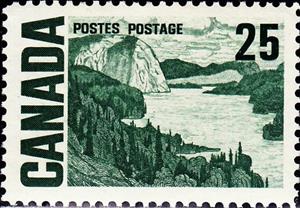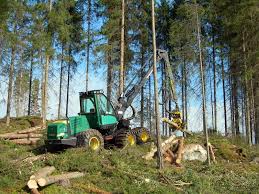Stamp: Solemn Land by J.E.H. MacDonald (Canada 1967)
Solemn Land by J.E.H. MacDonald (Canada 1967)
08 February (Canada ) within release Centennial definitives-High Values goes into circulation Stamp Solemn Land by J.E.H. MacDonald face value 25 Canadian cent
| Stamp Solemn Land by J.E.H. MacDonald in catalogues | |
|---|---|
| Michel: | Mi:CA 407Ax |
| Stamp Number: | Sn:CA 465 |
Stamp is horizontal format.
Also in the issue Centennial definitives-High Values:
- Stamp - Jack Pine by Tom Thompson face value 10;
- Stamp - Solemn Land by J.E.H. MacDonald face value 25;
Stamp Solemn Land by J.E.H. MacDonald it reflects the thematic directions:
A landscape is the visible features of an area of land, its landforms and how they integrate with natural or man-made features. A landscape includes the physical elements of geophysically defined landforms such as (ice-capped) mountains, hills, water bodies such as rivers, lakes, ponds and the sea, living elements of land cover including indigenous vegetation, human elements including different forms of land use, buildings and structures, and transitory elements such as lighting and weather conditions. Combining both their physical origins and the cultural overlay of human presence, often created over millennia, landscapes reflect a living synthesis of people and place that is vital to local and national identity. The character of a landscape helps define the self-image of the people who inhabit it and a sense of place that differentiates one region from other regions. It is the dynamic backdrop to people’s lives. Landscape can be as varied as farmland, a landscape park, or wilderness. The earth has a vast range of landscapes, including the icy landscapes of polar regions, mountainous landscapes, vast arid desert landscapes, islands and coastal landscapes, densely forested or wooded landscapes including past boreal forests and tropical rainforests, and agricultural landscapes of temperate and tropical regions.
Coastal areas are local administrative units (LAUs) that are bordering or close to a coastline. A coastline is defined as the line where land and water surfaces meet (border each other).
Forestry is the science and craft of creating, managing, planting, using, conserving and repairing forests and woodlands for associated resources for human and environmental benefits. Forestry is practiced in plantations and natural stands. The science of forestry has elements that belong to the biological, physical, social, political and managerial sciences. Forest management plays an essential role in the creation and modification of habitats and affects ecosystem services provisioning



